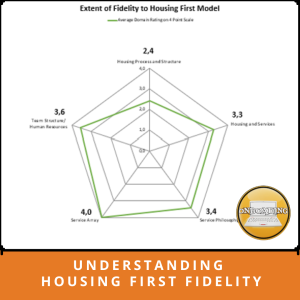Understanding Housing First Fidelity: Onboarding NEW

Available Summer ’24
Logistics
Type: Self-Paced / Onboarding
Time to Complete: 90 minutes
Target Audience: Executive Directors, managers, and supervisors of Housing First programs or programs that would like to be considered Housing First. This module is also appropriate for front-line staff working with people experiencing homelessness as well as system leadership where homelessness is being addressed.
Components
- Videos
- Text
- Exercises
- Knowledge Checks
- Final Assessment
- Course Evaluation
- Completion Certificate
Description
Almost all approaches to reducing and ending homelessness have determined the importance of being rooted in Housing First. This generally refers to the philosophical aspects of Housing First and is what we call “Housing First Friendly.” But within every system, there should also be formal Housing First programs or interventions because Housing First has become, based on research and in our opinion, the most effective direct service approach to supporting the most complex individuals experiencing homelessness. The At Home/Chez Soi project, the largest study ever done on the impact of Housing First, funded by Health Canada through the Mental Health Commission of Canada, implemented formal Housing First in five Canadian cities (Moncton, Montréal, Toronto, Winnipeg, and Vancouver) between 2009 and 2013 for people with a psychiatric disability who were homeless. This along with multiple other studies came to the same conclusion. The more closely a Housing First program adheres to the defined key elements and principles associated with the model, the greater the outcomes are for the program and more importantly, the consumer or program participants. Therefore, it has been essential that standards outlining the details of fidelity to the program be created, implemented, and assessed within these programs.
This module will discuss what Housing First fidelity means and dissect the various components of a fidelity assessment. We will also outline and discuss the different methods of assessing fidelity including the pros and cons of each. Learners will explore the most current “Fidelity Checklist” and even conduct their own program self-assessment.
Learning Objectives
- Define Housing First Fidelity.
- Understand the importance of maintaining a high degree of fidelity.
- Understand the different options for assessing program fidelity.
- Understand what to do once you have assessed the fidelity of your program.
